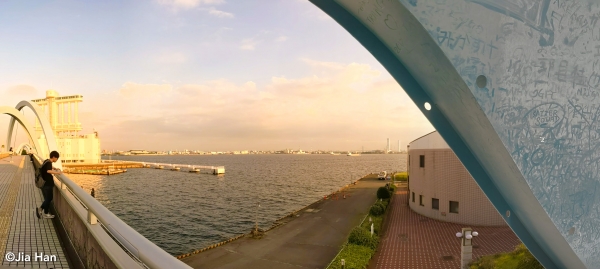Nagoya: Japan's Little Tanjong Pagar (Part 1)

In 2019, the stars aligned in the Japanese calendar, and there were a couple of consecutive long weekends in September due to two public holidays: Respect for the Aged Day and Autumnal Equinox Day. By just taking 4 days of leave, I cleared myself a 10-day mega-holiday to go travelling. One of the places I visited was Nagoya.
Nagoya is the capital of Aichi Prefecture, and an air travel hub. Honestly, I travelled here because I was on my way up to Ishikawa Prefecture to visit a friend, and Nagoya (specifically Chubu Centrair International Airport) happened to be where the low-cost carriers were. Nagoya is Japan’s fourth most populous city (yes, it beats places like Kyoto, Kobe, and Fukuoka) and a major port to boot. Nagoya Castle and Atsuta Shrine are the two biggest tourist draws that generally come to mind.
(Image Credit: Jia Han)
To me, Nagoya City felt like the Tanjong Pagar of Japan – expansive streets and office buildings aplenty. And just like Tanjong Pagar, food haunts face vigorous competition to entice the office crowd. Those that survive are the best, and many that I found were ensconced in classy office buildings rather than in bigger malls. Nagoya Maruhachi Shokudo, for example, was in the basement of Nagoya Lucent Tower, an intimidating 40-storey skyscraper with a lobby so posh I felt ashamed to enter in T-shirt and jeans.
Nagoya Maruhachi Shokudo Meieki
(Image Credit: Jia Han)
One specialty of Nagoya is miso katsu, made from red miso. While red miso is also made from soybeans, the longer fermentation period (compared to white miso) gives it a darker, richer flavour. The zesty tang and sweet-savoury goodness of the sauce gives the traditional porky katsu a lift that I personally find very refreshing.
(Image Credit: Jia Han)
Another food that Nagoya is famous for is Cochin chicken, a breed of chicken known for its darker, richer flavour (just like the miso). The meat is tougher and more flavourful compared to wakadori (young chicken), and generally comes at a higher price point as well. But it is not absolutely better –– I find the tender juicy lightness of wakadori just as appetizing, and the lighter burden on my wallet makes my chicken taste better, stingy traveller that I am. A good example of this is tebasaki (literally "chicken wing" in Japanese), where the star is the addictive seasoning sprinkled on the wing. A salty and addictive mix that I liken to Mamee noodle seasoning that will have you scarfing the chicken down.
Nagoya Maruhachi Shokudo Meieki (名古屋丸八食堂 名駅)
Address: 6-1 Ushijimacho, Nishi Ward, Nagoya, Aichi, 451-6090
Nearest station: Nagoya Station (Nagoya Lucent Tower Exit)
Opening hours: 11am–10:30pm (daily)
English menu available
Chasensai
(Image Credit: Jia Han)
One thing that Japan does not get right is bubble tea. For me, popular brands like The Alley and Koi are watery and weak in Japan, and the pearls are either tasteless, rubbery, or both. In fact, one of the first things I did upon beginning my new life in Kagoshima was to embark on a bubble tea spree across the city in search of my comfort drink. I was sorely disappointed.
Luckily, right across my hostel in a seedy alley of Nagoya was Chasensai, which was personally as good as any bubble tea I’ve had in Singapore –– creamy, tasty milk that wrought havoc on my lactose intolerance, and flavourful pearls that oozed flavour with every chew. I visited it daily.
Chasensai Sakaeten (茶千歳 栄店)
Address: 4 Chome-17-26 Sakae, Naka Ward, Nagoya, Aichi, 460-0008
Nearest station: Sakae Station / Sakaemachi Station (Exit 13)
Opening hours: 10am–Midnight
Toyota Commemorative Museum of Industry and Technology
(Image Credit: Jia Han)
Toyota, you say. Cars, I reply.
Wrong.
I was absolutely confused to walk into the Toyota Museum to find myself in a textile exhibition that stretched on for rooms and rooms. Housed in the red-brick weaving mill where the conglomerate all began, the guide was informative, and the exhibits well-curated. I learnt a lot about the industrialisation process of weaving. As a bonus, my tour group had a kid who enthusiastically answered every rhetorical question the tour guide posed, and the experienced guide kindly involved his young helper by passing him thread samples. I felt like I already had my money’s worth by the time I reached the cars.
(Image Credit: Jia Han)
Toyota Commemorative Museum of Industry and Technology (トヨタ産業技術記念館)
Address: 4 Chome-1-35 Noritakeshinmachi, Nishi Ward, Nagoya, Aichi, 451-0051
Nearest station: Sakō Station
Opening hours: 9:30am–5pm
Admission fee: ¥500 (~S$6.50)
For a city guy like me, Nagoya was excellent. Picturesque meanders through the cityscape and good food make me happy. And as with all office-heavy districts like Nagoya City and Tanjong Pagar: by avoiding the peak lunch hours and rush hours, you will easily find yourself in the very best places with nary a queue on weekdays. I found a relaxed side of Nagoya, as long as I ate my brunches, late lunches, and late dinners, an itinerary perfect for a lazy holiday.
That’s all for part 1 folks. Please like, subscribe, and share.
If you're ready for part 2, proceed.
Related Articles
- Nagoya: Japan's Little Tanjong Pagar (Part 2)
- Gorge-ous Naruko: A beginner's guide to Miyagi Prefecture's top autumn spot (Part 1)
- The secret diary of Ghibli Museum: a rare glimpse into the museum, virtually





